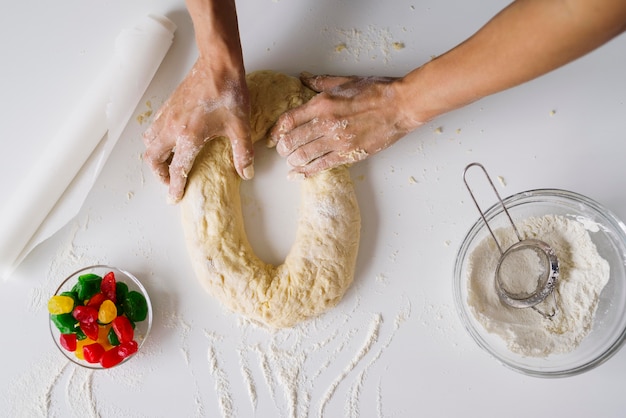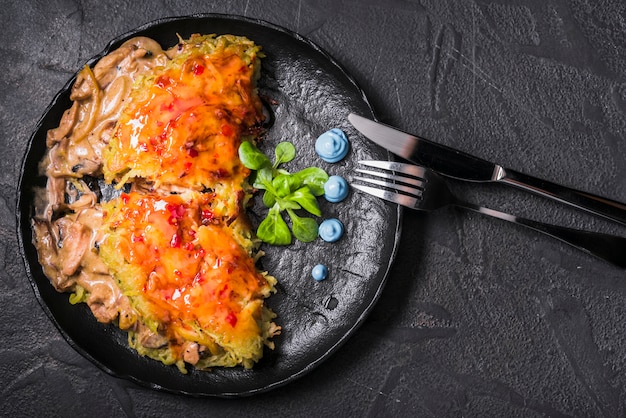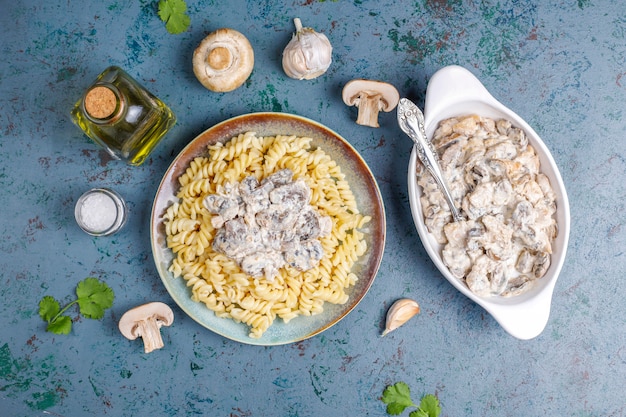Let's talk about chicken alfredo. Not just any Chicken Alfredo, mind you, but the kind that makes you sigh with pure contentment, the kind that has you licking the plate clean, the kind that your partner will happily fight you for the last bite of. This isn't just about throwing some pasta, chicken, and cream together (although, that does work in a pinch!). It's about building flavour, crafting texture, and ultimately, creating a culinary masterpiece that will leave you feeling like a true Italian chef. Buckle up, buttercup, because we're about to embark on a delicious journey together.
(Part 1) The Foundations: Choosing Your Ingredients

The Star of the Show: The Pasta
The first thing you need to do is choose your pasta. Now, I'm a big fan of linguine for this dish. Its long, flat strands hold the sauce perfectly, allowing you to capture every last drop. Imagine, twirling a forkful, the sauce clinging to the pasta like a warm, creamy blanket. But, hey, it's your kitchen, your rules! Feel free to experiment with other shapes like fettuccine, which offers a similar surface area to linguine for sauce absorption, or even penne, for a more bite-sized experience.
The Secret Weapon: The Cheese
Now, we're talking Parmesan cheese here, folks. You can't even think about skipping this one! It's the backbone of the alfredo sauce. Imagine the sharp, nutty flavour of freshly grated Parmesan melting into the creamy sauce, creating a symphony of taste that will leave you speechless. Go for the good stuff, the grated kind, not that pre-shredded stuff from the supermarket. Trust me, it makes a difference. The fresh, granular texture of grated Parmesan will melt into the sauce more evenly, creating a silkier, smoother consistency.
The Unsung Hero: The Butter
You want a butter that's going to melt smoothly and add a rich, buttery flavour to your sauce. Don't go cheap here, use unsalted butter for the best results. Think about that luxurious, velvety texture that high-quality butter offers, coating your tongue and creating a symphony of richness in every bite. And trust me, you won't regret it.
The Essential Ingredient: The Chicken
I'm all for a good, juicy chicken breast for this dish. But if you're feeling fancy, try using boneless, skinless chicken thighs. They're a bit more forgiving and tend to stay moist, even after cooking. Remember, the goal is to create a dish where every element sings in harmony, and juicy chicken is crucial to that symphony of flavour.
The Final Touch: The Garlic
Ah, garlic, the magic ingredient! A little goes a long way, so don't overdo it. Remember, we're aiming for a subtle, fragrant flavour, not a full-blown garlic bomb. A whisper of garlic, just enough to tantalize the taste buds without overpowering the other ingredients, is all you need.
(Part 2) The Sauce: Creamy, Dreamy, Delicious

Step 1: Melt That Butter
Alright, grab your largest frying pan, and let's get started. Heat that butter over medium heat until it's melted and shimmering. You want it nice and hot, but not smoking. The melted butter will serve as the base for the sauce, creating that rich, luxurious flavour that is the hallmark of a good Alfredo.
Step 2: Sautee the Garlic
Add your minced garlic to the melted butter and let it cook for about 30 seconds. This is crucial, you want to release that garlic flavour but not let it burn. The garlic, while subtle, will add a layer of complexity to the sauce, enhancing the overall flavour profile.
Step 3: Build the Base
Now, it's time to add your heavy cream. Now, this is where you need to be careful. You want to simmer the cream, not boil it. You'll notice the cream starting to thicken, almost like a gravy. The heavy cream is the heart and soul of the Alfredo sauce. It's what gives it that creamy, luscious texture and adds a touch of richness that will make you swoon.
Step 4: Let the Cheese Shine
Now, it's time to add the Parmesan cheese. Add it gradually, stirring constantly until it's melted and smooth. This is where the magic happens, folks. You'll start to see the creamy sauce come together, and you'll start to smell that irresistible cheesy aroma. The Parmesan cheese is the final touch, adding that sharp, nutty flavour that perfectly complements the creamy sauce.
Step 5: Seasoning and Taste
Add a pinch of salt and pepper to taste. You can even add a touch of nutmeg, if you're feeling adventurous. Remember, the key here is to taste as you go. You want to make sure that the sauce is perfectly seasoned and to your liking. The right amount of seasoning will bring out the best in your ingredients, creating a harmonious flavour that will dance on your tongue.
Step 6: Don't Overcook
Now, this is important. You don't want to overcook your sauce. It will start to separate and become oily. Once the cheese has melted and the sauce is smooth and creamy, it's done. The key is to stop at the perfect moment, before the sauce becomes too thick or too oily.
(Part 3) Cooking the Chicken: The Perfect Bite

Step 1: Season to Perfection
Salt and pepper are your best friends here. Season your chicken generously on both sides. You want that beautiful crust to form when it's cooked. Think about the flavour profile you're building. Salt and pepper will enhance the natural flavours of the chicken, creating a well-rounded taste.
Step 2: Searing for Flavour
Heat a little olive oil in a separate pan over medium-high heat. Add your chicken and cook for about 3-4 minutes per side, until golden brown and nicely seared. The sear will add a touch of smokiness and depth to the chicken, adding another layer of flavour to the dish.
Step 3: Rest and Recover
Remove the chicken from the pan and let it rest for a few minutes before slicing it. This allows the juices to redistribute, resulting in a juicy and tender chicken. Think about the texture you want to achieve. Letting the chicken rest allows the juices to redistribute, resulting in a juicy and tender chicken that will melt in your mouth.
(Part 4) Bringing it All Together: A Symphony of Flavour
Step 1: Cook the Pasta
Bring a large pot of salted water to a boil. Add your pasta and cook according to the package directions, until al dente. The al dente pasta will hold its shape in the sauce, creating a satisfying bite and a delightful texture.
Step 2: Drain the Pasta
Drain the pasta and reserve a cup of the pasta water. This will be your secret weapon for making the sauce even smoother and creamier. The pasta water will help to thin the sauce, creating a creamy and luxurious texture that will coat the pasta perfectly.
Step 3: Combine the Elements
Add the cooked pasta to the sauce. Toss to coat evenly. If the sauce seems too thick, add a little of the reserved pasta water, a tablespoon at a time, until you achieve your desired consistency. Remember, the key here is balance. You want a sauce that's thick enough to coat the pasta but not so thick that it's heavy.
Step 4: Add the Chicken
Add the sliced chicken to the pasta and sauce. Toss gently to combine. The chicken, cooked to perfection and bursting with flavour, will bring another dimension to the dish, complementing the creamy sauce and the al dente pasta.
Step 5: The Grand Finale
Serve immediately, garnished with fresh parsley, a sprinkle of Parmesan cheese, and a drizzle of olive oil. The parsley will add a touch of freshness, the Parmesan cheese will enhance the cheesy flavour, and the olive oil will add a touch of richness and depth.
(Part 5) Variations on a Classic: Explore the Possibilities
The Spicy Option: Add a Kick
For those who like a bit of heat, add a pinch of red pepper flakes to the sauce. Just a little bit will go a long way! The red pepper flakes will add a touch of heat and spice to the creamy sauce, creating a dish that's both comforting and exciting.
The Vegetarian Option: Leave Out the Chicken
You can easily make a vegetarian version of Chicken Alfredo by simply omitting the chicken. Add some sautéed mushrooms, spinach, or roasted vegetables to the sauce for extra flavour and texture. The mushrooms will add a meaty texture and a savory flavour, the spinach will add a touch of freshness, and the roasted vegetables will bring a touch of sweetness and complexity to the dish.
The Seafood Option: Embrace the Ocean
For a lighter and more refreshing option, try substituting the chicken with grilled or sautéed shrimp, scallops, or even smoked salmon. The shrimp, scallops, or salmon will add a delicate flavour and a lighter texture to the dish, making it perfect for a warm summer evening.
The Gourmet Option: Elevate the Dish
For a truly luxurious experience, try adding a splash of white wine to the sauce. You can also experiment with different types of cheese, such as Gruyère or Fontina, for a more complex flavour profile. The white wine will add a touch of acidity and complexity to the sauce, while the Gruyère or Fontina will add a richer, more nuanced flavour.
(Part 6) Beyond the Plate: Serving Suggestions
A Simple Side Salad: Light and Refreshing
A simple salad with fresh greens, a light vinaigrette, and a sprinkle of parmesan cheese is a classic pairing for Chicken Alfredo. The salad will add a touch of freshness and acidity to the dish, balancing the richness of the Alfredo sauce.
Garlic Bread: The Perfect Accompaniment
No Chicken Alfredo meal is complete without a side of garlic bread. It's the perfect way to soak up all that delicious sauce. The garlic bread will add a touch of warmth and comfort to the dish, making it the perfect meal for a cold winter night.
A Touch of Sweetness: A Fruity Side
If you're feeling adventurous, try serving your Chicken Alfredo with a side of roasted or grilled fruit, like peaches, pears, or apricots. The sweetness will balance out the richness of the dish. The fruit will add a touch of sweetness and acidity to the dish, creating a complex and satisfying flavour profile.
(Part 7) Tips and Tricks: Master the Art
Don't Overcrowd the Pan:
Give your chicken plenty of room to cook evenly and develop a nice sear. If you overcrowd the pan, the chicken will steam instead of sear and you won't get that delicious crust. Remember, the goal is to create a beautiful, golden-brown sear on the chicken, which will add depth and flavour to the dish.
Don't Overcook the Garlic:
Garlic burns easily, so keep a close eye on it. If it starts to brown, it's overcooked and will have a bitter flavour. The garlic should be cooked just long enough to release its flavour but not so long that it burns. A burnt garlic flavour will ruin the entire dish.
Don't Overcook the Pasta:
Al dente pasta is key for a good Chicken Alfredo. Overcooked pasta will become mushy and won't hold its shape in the sauce. The al dente pasta will hold its shape and texture in the sauce, creating a more satisfying bite.
Don't Overcook the Sauce:
The sauce should be creamy and smooth, not thick and oily. If you overcook it, the butter will separate and the sauce will become grainy. The key is to stop at the perfect moment, before the sauce becomes too thick or too oily.
Don't Over-Salt:
Remember, the cheese already contains salt. Start with a small amount of salt and adjust to taste as you go. The Parmesan cheese is already salty, so over-salting the dish will only make it taste worse.
(Part 8) Troubleshooting: When Things Go Wrong
My sauce is too thick:
Add a little of the reserved pasta water, a tablespoon at a time, until you achieve your desired consistency. The pasta water will help to thin the sauce, creating a smoother and more creamy texture.
My sauce is too thin:
Add a tablespoon or two of grated Parmesan cheese to thicken the sauce. The Parmesan cheese will help to thicken the sauce without adding any extra flavour.
My chicken is dry:
Make sure to rest the chicken for a few minutes after cooking before slicing it. This allows the juices to redistribute, resulting in a more tender and juicy chicken. Letting the chicken rest allows the juices to redistribute, resulting in a more tender and juicy chicken.
My garlic is burnt:
If your garlic is burnt, start over with a fresh batch of sauce. Burnt garlic will have a bitter taste that will ruin the flavour of the entire dish. A burnt garlic flavour will ruin the entire dish, so it's best to start over if you burn the garlic.
My pasta is overcooked:
If your pasta is overcooked, it will be mushy and won't hold its shape in the sauce. Unfortunately, there's not much you can do to fix this. Try making a fresh batch of pasta and using the sauce as is. The overcooked pasta will be mushy and won't hold its shape in the sauce, so it's best to start over with a fresh batch of pasta.
(Part 9) FAQs: All Your Burning Questions Answered
Q: Can I make this ahead of time?
A: Yes, you can! The sauce and chicken can be made ahead of time and stored separately in the refrigerator. Reheat the sauce over low heat before adding the pasta and chicken. Making the sauce and chicken ahead of time will save you time when you're ready to eat. Just make sure to reheat the sauce thoroughly before adding the pasta and chicken.
Q: Can I freeze this?
A: It's best not to freeze the entire dish. The pasta will become mushy when thawed. However, you can freeze the sauce separately in an airtight container for up to 3 months. Thaw the sauce in the refrigerator overnight before reheating. Freezing the sauce separately will allow you to enjoy a delicious chicken Alfredo whenever you want. Just make sure to thaw the sauce thoroughly before reheating.
Q: What kind of wine can I use?
A: A dry white wine, such as Sauvignon Blanc or Pinot Grigio, will work best for this dish. It will add a subtle complexity to the sauce without overpowering the other flavours. The white wine will add a touch of acidity and complexity to the sauce, without overpowering the other flavours.
Q: Can I use heavy whipping cream instead of heavy cream?
A: You can use heavy whipping cream, but the sauce may be slightly thicker and richer. If you're looking for a lighter sauce, use heavy cream. The heavy whipping cream will create a slightly thicker and richer sauce, while the heavy cream will create a lighter and less rich sauce.
Q: What can I do if I don't have any Parmesan cheese?
A: You can use a blend of other hard cheeses, such as Gruyère, Fontina, or Pecorino Romano. However, the flavour will be different. Parmesan cheese is the traditional and most preferred cheese for Chicken Alfredo. While other hard cheeses can be used, Parmesan is the traditional and most preferred cheese for Chicken Alfredo, so it's the best option if you can get it.
Conclusion: The Perfect Plate Awaits
There you have it, folks! The ultimate guide to creamy Chicken Alfredo. Now, go out there and get cooking! Remember, the key is to have fun, experiment with different ingredients and flavours, and most importantly, enjoy the process. Because at the end of the day, a good plate of Chicken Alfredo is all about sharing a delicious meal with the people you love.
Everyone is watching

Corn on the Cob: The Ultimate Guide to Perfectly Cooked Ears
Healthy MealsAh, corn on the cob. Just the name evokes images of sunny days, barbecues, and that sweet, juicy flavour that ...

Perfect Pork Roast Oven Cooking Time: A Guide to Delicious Results
Healthy MealsThere's something truly satisfying about a perfectly roasted pork. The aroma alone is enough to make your mout...

Ham Cooking Time: How Long to Bake, Smoke, or Boil a Delicious Ham
Healthy MealsAh, ham. It's a classic, isn't it? A real crowd-pleaser, especially around holidays. And when done right, it'...

Scallops: The Ultimate Guide to Perfect Cooking
Healthy MealsAh, scallops. Those delicate, sweet, and utterly delicious morsels of the sea. They hold a special place in my...

Spaghetti Squash: The Ultimate Guide to Cooking and Serving
Healthy MealsRemember that time you saw spaghetti squash at the supermarket, looking all bumpy and strange, and thought, "W...
